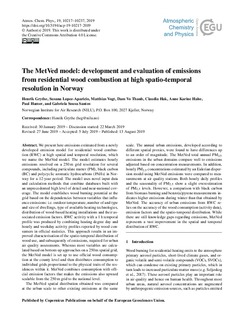| dc.contributor.author | Grythe, Henrik | |
| dc.contributor.author | Lopez-Aparicio, Susana | |
| dc.contributor.author | Vogt, Matthias | |
| dc.contributor.author | Vo, Dam Thanh | |
| dc.contributor.author | Hak, Claudia | |
| dc.contributor.author | Halse, Anne Karine | |
| dc.contributor.author | Hamer, Paul David | |
| dc.contributor.author | Sousa Santos, Gabriela | |
| dc.date.accessioned | 2019-08-15T12:05:44Z | |
| dc.date.available | 2019-08-15T12:05:44Z | |
| dc.date.created | 2019-08-13T16:33:45Z | |
| dc.date.issued | 2019 | |
| dc.identifier.citation | Atmospheric Chemistry and Physics. 2019, 19 10217-10237. | nb_NO |
| dc.identifier.issn | 1680-7316 | |
| dc.identifier.uri | http://hdl.handle.net/11250/2608512 | |
| dc.description.abstract | We present here emissions estimated from a newly developed emission model for residential wood combustion (RWC) at high spatial and temporal resolution, which we name the MetVed model. The model estimates hourly emissions resolved on a 250 m grid resolution for several compounds, including particulate matter (PM), black carbon (BC) and polycyclic aromatic hydrocarbons (PAHs) in Norway for a 12-year period. The model uses novel input data and calculation methods that combine databases built with an unprecedented high level of detail and near-national coverage. The model establishes wood burning potential at the grid based on the dependencies between variables that influence emissions: i.e. outdoor temperature, number of and type and size of dwellings, type of available heating technologies, distribution of wood-based heating installations and their associated emission factors. RWC activity with a 1 h temporal profile was produced by combining heating degree day and hourly and weekday activity profiles reported by wood consumers in official statistics. This approach results in an improved characterisation of the spatio-temporal distribution of wood use, and subsequently of emissions, required for urban air quality assessments. Whereas most variables are calculated based on bottom-up approaches on a 250 m spatial grid, the MetVed model is set up to use official wood consumption at the county level and then distributes consumption to individual grids proportional to the physical traits of the residences within it. MetVed combines consumption with official emission factors that makes the emissions also upward scalable from the 250 m grid to the national level. The MetVed spatial distribution obtained was compared at the urban scale to other existing emissions at the same scale. The annual urban emissions, developed according to different spatial proxies, were found to have differences up to an order of magnitude. The MetVed total annual PM2.5 emissions in the urban domains compare well to emissions adjusted based on concentration measurements. In addition, hourly PM2.5 concentrations estimated by an Eulerian dispersion model using MetVed emissions were compared to measurements at air quality stations. Both hourly daily profiles and the seasonality of PM2.5 show a slight overestimation of PM2.5 levels. However, a comparison with black carbon from biomass burning and benzo(a)pyrene measurements indicates higher emissions during winter than that obtained by MetVed. The accuracy of urban emissions from RWC relies on the accuracy of the wood consumption (activity data), emission factors and the spatio-temporal distribution. While there are still knowledge gaps regarding emissions, MetVed represents a vast improvement in the spatial and temporal distribution of RWC. | nb_NO |
| dc.language.iso | eng | nb_NO |
| dc.rights | Navngivelse 4.0 Internasjonal | * |
| dc.rights.uri | http://creativecommons.org/licenses/by/4.0/deed.no | * |
| dc.title | The MetVed model: development and evaluation of emissions from residential wood combustion at high spatio-temporal resolution in Norway | nb_NO |
| dc.type | Journal article | nb_NO |
| dc.type | Peer reviewed | nb_NO |
| dc.description.version | publishedVersion | nb_NO |
| dc.rights.holder | © Author(s) 2019. | nb_NO |
| dc.source.pagenumber | 10217-10237 | nb_NO |
| dc.source.volume | 19 | nb_NO |
| dc.source.journal | Atmospheric Chemistry and Physics | nb_NO |
| dc.identifier.doi | 10.5194/acp-19-10217-2019 | |
| dc.identifier.cristin | 1715682 | |
| dc.relation.project | Miljødirektoratet: 201/8676 | nb_NO |
| dc.relation.project | Norges forskningsråd: 247884 | nb_NO |
| dc.relation.project | Nordforsk: 75007 | nb_NO |
| cristin.unitcode | 7460,54,0,0 | |
| cristin.unitcode | 7460,60,0,0 | |
| cristin.unitname | By og industri | |
| cristin.unitname | Miljøkjemi | |
| cristin.ispublished | true | |
| cristin.fulltext | original | |
| cristin.qualitycode | 2 | |

